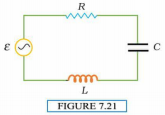Question 7.11:
Figure 7.21 shows a series LCR circuit connected to a variable frequency 230 V source. L = 5.0 H, C = 80uF, R = 40

(a) Determine the source frequency which drives the circuit in resonance.
(b) Obtain the impedance of the circuit and the amplitude of current at the resonating frequency.
(c) Determine the RMS potential drops across the three elements of the circuit. Show that the potential drop across the LC combination is zero at the resonating frequency.
Given that the Inductance of the inductor in the circuit is, L = 5.0 H
Given that the Capacitance of the capacitor in the circuit is, C = 80 μH = 80 × 10 – 6 F
Given that Resistance of the resistor in the circuit, R = 40 Ω
Value of Potential of the variable voltage supply, V = 230 V
(a) Resonance angular frequency is given as:
Hence, the circuit Will come in resonance for a source frequency of 50 rad/s.
(b) Impedance of the circuit is given by the relation:
At resonance,
The amplitude of the current at the resonating frequency is given as:
Where, = Peak voltage =
Hence, at resonance, the impedance of the circuit is 40 and the amplitude of the current is 8.13 A.
(c) rms potential drop across the inductor,
( V L ) rms = I x ω r L
Where
The potential drop across the capacitor:
The potential drop across the resistor:
The potential drop across the LC combination:
At resonance,
Hence, it is proved that the potential drop across the LC combination is zero at resonating frequency.

© 2025 GoodEd Technologies Pvt. Ltd.